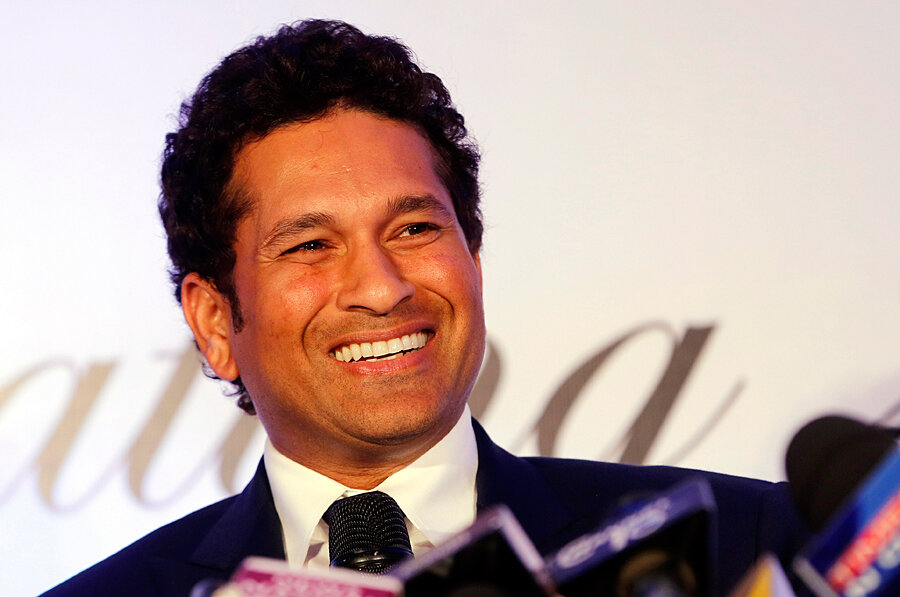Sachin Tendulkar: the most popular athlete you've never heard of
| Mumbai, India
Think Michael Jordan, but bigger. Think Wayne Gretzky, but more adored. Think Pele, but possibly more revered. Combine them into a single athlete and you might begin to capture the adoration Indians have for cricket star Sachin Tendulkar.
In a country with 18 official languages, simmering religious tensions, and 1.2 billion people, cricket remains one of the only common bonds. So when the 40-year-old Mr. Tendulkar played the final game of his career on Saturday the nation heaved a collective, wistful sigh.
“God has retired,” said 10-year-old Niwaz Ahmed, who was among the dozens of boys playing cricket on the pavement outside a Mumbai apartment complex the day after Tendulkar’s retirement.
For Indians young and old, Tendulkar inspires nearly unrivaled devotion. In a recent poll by the Indian magazine Outlook and CNN-IBN, Indians voted on the greatest Indian after Gandhi. Tendulkar was the only Indian born after 1947 to rank in the top 10.
Millions of television viewers watched Tendulkar lead the Indian side to victory against the West Indies, and then give a farewell speech, thanking a long list of family members and friends for supporting him, especially his father.
"He gave me freedom at the age of 11, and told me that [I should] chase my dreams, but make sure you do not find shortcuts," he said tearfully. "The path might be difficult but don't give up, and I have simply followed his instructions."
The Indian government immediately afterward awarded Tendulkar the highest national award for a civilian.
Cricket’s popularity in India can’t be understated. There are dozens of leagues, scores of teams throughout the country; big games such as international test matches against rivals Pakistan, England, and Australia routinely draw viewership that dwarfs, for example, the Super Bowl in the United States. In the 2011 semifinal World Cup game against Pakistan, an estimated 1.5 billion people tuned in to watch the game.
Tendulkar made his international debut at 16 in a game against Pakistan, India’s biggest rival. He represented India internationally, and Mumbai domestically for 24 years – longer than Michael Jordan played in the NBA. He helped India win the World Cup in 2011 against Sri Lanka, the first win in nearly 30 years, and earned a reputation as one of the best batsmen of his generation.
“Amid scams and violence, corruption and terrorism, we have hankered for that one Indian who can rid us of widespread cynicism: someone to give us a sense of pride, hope and identity in a complex universe, someone who gives us a self-belief that we can compete and be the best,” Indian journalist Rajdeep Sardesai wrote in an article published ahead of Tendulkar’s last match in the magazine Outlook. “With Tendulkar, our search for the ultimate cricket hero ended.”
Part of Tendulkar’s popularity had to do with timing. His growth in renown coincided with the opening up of the Indian economy and the proliferation of television.
That meant “for the first time an Indian hero could actually be seen by millions all over the country,” says Abhishek Mukherjee, a writer for CricketCountry.com.
Even as India’s economy posted enviable growth rates, the country remained politically unstable and regularly rocked by sectarian violence. Tendulkar distracted Indians from their insecurities, social historian Ramachandra Guha says.
A medium-height son of middle class parents without previous cricket connections, Tendulkar won respect for his hard work and dominance against international players who physically towered over him. He also maintained a squeaky-clean image while match-fixing scandals tarnished the Indian cricket league.
International players have admired the Indian cricket ecosystem where kids play cricket all year long and aren’t distracted by other sports. Soccer, for example, rivals cricket in only a handful of southern Indian states, and the only other sports that get any popularity are field hockey, badminton, and chess.
Cricket coach Naushad Khan built an astro-turf pitch on the veranda in front of his Mumbai apartment so his boys could practice when the public fields were busy. He summed up the sentiment people have toward Tendulkar.
“Every father wants their son to be a Sachin,” he says.





